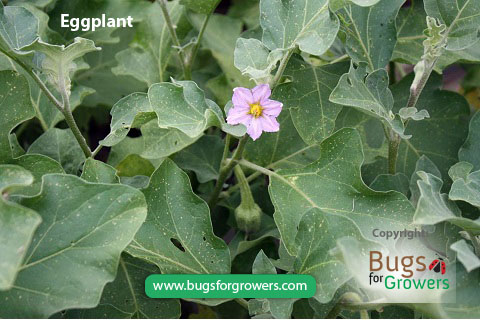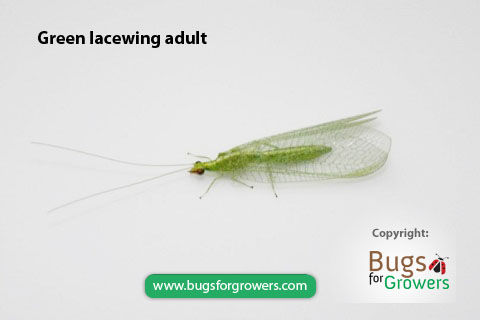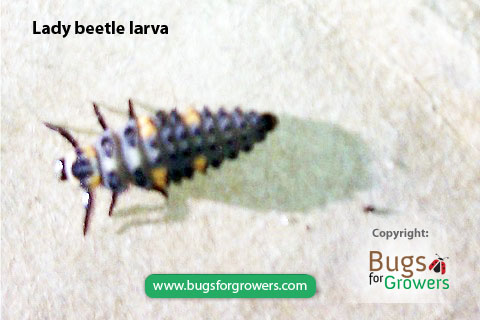Two predatory insects, green lacewing and two spotted lady beetle are currently used for the control of cotton aphids
There are several types of natural enemies including predatory and endoparasitic insects that are feed on different species of aphids and help to keep aphid population under control. Of the several naturally occurring parasites and predators, green lacewing (Chrysopa carnea) and two spotted lady beetle (Adalia bipunctata) have shown a potential to control cotton aphids, (Aphis gossypii), which are known to transmit cucumber mosaic virus (CMV) to many of their host plants.
Watch YouTube video about biological control of aphids with green lacewings.
What are cotton aphids?
Cotton aphids are scientifically called as Aphis gossypii. They are tiny about 1 to 10 mm long, pear-shaped and soft- bodied insects that cause a serious damage to many agricultural and horticultural crops, and ornamental plants. Aphids tend to live in colonies. Each such colony of aphids consists of a mixture of baby aphids called nymphs, winged and wingless adults. The wingless forms have ovoid body shape and green shades whereas winged forms have black colored head and thorax, greenish colored abdomen and fusiform body. In addition to cotton crop, this aphid can cause damage to several different economically important host crops including cantaloupe, citrus, cucumber (Fig. 1.), eggplants (Fig. 2.), green pepper (Fig. 3.), okra (Fig. 4.), pumpkin (Fig. 5.), squash and watermelon. Both the adults and nymphs have piercing and sucking type of mouthparts that they use for sucking cell sap (juice) from all the tender plant parts including buds, stems and leaves. Heavy feeding by both adults and nymphs can cause yellowing of leaves that eventually dry and fall off prematurely from the plant. Aphids also transmit different types of disease causing viruses like cucumber mosaic virus (CMV) to many plant species that causes a tremendous economic loss to all the agricultural, horticultural and greenhouse industries.





What is a cucumber mosaic virus?
This virus is called cucumber mosaic virus because it was first discovered on cucumber. In addition to cucumber, CMV infects several plant species including bean, celery, lettuce, pepper, spinach, squash and tomato. Although the CMV symptoms differ among plant species, major symptoms generally includes chlorosis and mosaic of young leaves, development of ringspot patterns on fruits and leaves, wrinkling of leaves, stunted and bushy growth, and inward rolling of leaves.
Biological control of aphids
Use of chemical pesticides is not allowed in organic productions due to their detrimental effects on human and animal health, and the environment. Therefore, it is essential to use beneficial insect like green lacewing (Chrysopa carnea) and two spotted lady beetle (Adalia bipunctata) as a safe biological alternative to chemical pesticides to control aphids and reduce the crop losses caused by them in the organic productions.
What are green lacewing, Chrysopa carnea?
Green lacewing, Chrysopa carnea is considered as predatory insect because its larvae directly munch on all the stages of aphids and other soft-bodied insects. Larvae of green lacewing look like tiny alligators. These larvae have a pair of long piercing type of mandibles that they use for catching aphids and injecting digestive enzymes into aphid’s body. These enzymes liquify internal organs of aphids. Lacewing larvae then feed on the liquified body content. Each larva of lacewing can feed over 50 aphids per day. Adults of green lacewing are bright green in color with long antennae and glossy eyes (Fig. 6.). Adults are not predatory in nature meaning they do not feed any other insects or organisms but they survive by feeding on pollen and nectar.
Green lacewings Chrysopa carnea are commercially supplied as larvae, which should be released in the field or garden immediately upon their arrival. They are generally released by tapping out of container on the aphid infested plants or they can be transferred as an individual larva with a fine brush on aphid infested plant leaves or twigs.
Depending on the intensity of aphid infestation green lacewings Chrysopa carnea can be released at the following rates for best control of aphids.
- Low aphid incidence: Release 5-6 larvae of green lacewing per 10 square feet bi-weekly for 2-3 times
- Medium aphid incidence: Release 8-10 larvae of green lacewing per 10 square feet bi-weekly for 2-3 times
- Heavy aphid incidence: Release 12-15 larvae of green lacewing per 10 square feet bi-weekly for 2-3 times

What are two spotted lady beetle, Adalia bipunctata?
Two spotted lady beetles, Adalia bipunctata are one of the best known predators that feed on different species of aphids. Both the adults and larvae of lady beetle feed on adults as well as nymphs of aphids. Adult lady beetles can be red or black in color. As name implies, adults have two spots, one on the center of each of two fore wings. The black colored lady beetles have two red spots whereas red colored beetles have two black spots. Female beetles generally lay a cluster of 25-50 yellow to orange colored and ovoid-shaped eggs per day on the leaves nearby a aphid colony. Eggs hatch within a week into small larvae that start feeding on aphids and develop through four developmental stages. Larvae of two spotted lady beetle also look like tiny alligators with six legs, greyish black color, and a few yellow and white spots on the body. Matured larvae pupate on the leaves or on any hard surface. After 5-6 days, adult beetles start emerging from pupae.
Two spotted lady beetles, Adalia bipunctata are commercially supplied as larvae (Fig. 7.), which should be released in the field or garden immediately upon their arrival. They are generally released near to aphid colonies on the aphid infested plants or they can be transferred as an individual larva with a fine brush on aphid infested plant leaves or twigs. If they are supplied in jute bugs, hang those bags on the twigs of the plants that are heavily infested with aphids. Generally ants are present in aphid colonies because they like to feed on honeydew excreted by aphids. Since these ants can attack and kill lady beetle to protect aphid colonies, they should be eliminated before releasing lady beetle larvae on the plants.
Depending on intensity of aphid infestation larvae of two spotted lady beetle, Adalia bipunctata should be released at the following rates for best control of aphids
- Low aphid incidence: Release 5-10 larvae of two spotted lady beetle per plant bi-weekly for 1- 2 times
- Medium aphid incidence: Release 10-15 larvae of two spotted lady beetle per plant bi-weekly for 2-3 times
- Heavy aphid incidence: Release 15-25 larvae of two spotted lady beetle per plant bi-weekly for 2-3 times

Research Papers
- Aqueel, M.A., Collins, C.M., Raza, A.M., Ahmad, S., Tariq, M. and Leather, S.R. 2014 Effect of plant nutrition on aphid size, prey consumption, and life history characteristics of green lacewing. Insect Science 21: 74-82.
- Enkegaard, A., Sigsgaard, L. and Kristensen, K. 2013. Shallot aphids, Myzus ascalonicus, in strawberry: Biocontrol potential of three predators and three parasitoids. Journal of Insect Science (Tucson) 13:1-16.
- Garzon, A., Budia, F., Medina, P., Morales, I., Fereres, A. and Vinuela, E. 2015. The effect of Chrysoperla carnea (Neuroptera: Chrysopidae) and Adalia bipunctata (Coleoptera: Coccinellidae) on the spread of cucumber mosaic virus (CMV) by Aphis gossypii (Hemiptera: Aphididae). Bulletin of Entomological Research 105: 13-22.
- Jalali, M.A. and Michaud, J.P. 2012. Aphid-plant interactions affect the suitability of Myzus spp. as prey for the two spot ladybird, Adalia bipunctata (Coleoptera: Coccinellidae). European Journal of Entomology 109: 345-352.
- Lommen, S.T.E., Holness, T.C., van Kuik, A.J., de Jong, P.W. and Brakefield, P.M. 2013. Releases of a natural flightless strain of the ladybird beetle Adalia bipunctata reduce aphid-born honeydew beneath urban lime trees. Biocontrol 58: 195-204.
- Mehrnejad, M.R., Vahabzadeh, N. and Hodgson, C.J. 2015. Relative suitability of the common pistachio psyllid, Agonoscena pistaciae (Hemiptera: Aphalaridae), as prey for the two-spotted ladybird, Adalia bipunctata (Coleoptera: Coccinellidae). Biological Control 80: 128-132.
- Nadeem, S., Hamed, M., Ishfaq, M., Nadeem, M. K., Hasnain, M. and Saeed, N. A. 2014. Effect
of storage duration and low temperatures on the developmental stages of Chrysoperla carnea (stephens) (Neuroptera: Chrysopidae). Journal of Animal and Plant Sciences 24: 1569-1572. - Sarwar, M. 2014. The propensity of different larval stages of lacewing Chrysoperla carnea (Stephens) (Neuroptera: Chrysopidae) to control aphid Myzus persicae (Sulzer) (Homoptera: Aphididae) evaluated on Canola Brassica napus L. Songklanakarin Journal of Science and Technology 36:143-148.
- Shrestha, G. and Enkegaard, A. 2013. The green lacewing, Chrysoperla carnea: Preference between lettuce aphids, Nasonovia ribisnigri, and western flower thrips, Frankliniella occidentalis. Journal of Insect Science (Tucson) 13:1-10.
